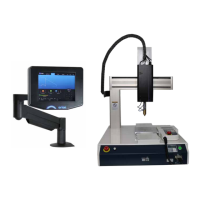11
Chapter 4: User Interface
e Orion i2 automatically detects when an EV weld head is connected to the “Acc. Port” and is powered
on. If the 250i2 fails to detect the weld head, refer to the FAQ page in this user manual for common
solutions.
If a weld head is detected, the i2 will automatically enter the EV screen and hide the other options such as
“Arc”, “Tack”, and “Metals” tab. e auto trigger option is disabled along with seam and rapid fire modes.
EV Screen - Control Area
is section contains the different controls to customize the i2 ‘s settings for welding output.
POWER CONTROL
is circular dial controls and selects the amount of weld energy or weld power used based on the
waveform selected.
Users can touch or slide along the circular path to adjust and set the weld energy. Notice that the dial’s
controls are non-linear—is allows users greater refinement and control when selecting lower level
settings. is means, when welding with the classic waveform, the first section of the dial represents
0.01 – 1.5 Joules; the next section represents 1.5 – 3 Joules, the third represents 3 - 5 Joules, the fourth
represents 5 - 30 Joules, and the final represents 30 - 200 or 250 Joules (depending on model).
Additionally, users can input weld energy settings via a number pad. To access the number pad, tap on
the weld energy numbers inside the dial. is allows users to directly enter the exact desired weld energy
values. Once the numeric value is entered, tap OK to set the value and exit the number pad.
WAVEFORM
e waveform selections determine and control how energy is released when welds are made.
CLASSIC e classic waveform is the default waveform for welding on all Orion welders. It has a high peak
current, which is the peak of the energy level, followed by a curved discharge slope. e curved discharge
slope allows the weld spots to cool with less internal stress, and without surface ripples. Classic welds will
typically have a smoother surface than other waveforms.

